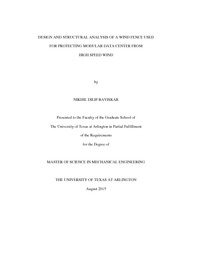
ATTENTION: The works hosted here are being migrated to a new repository that will consolidate resources, improve discoverability, and better show UTA's research impact on the global community. We will update authors as the migration progresses. Please see MavMatrix for more information.
Show simple item record
| dc.contributor.author | Baviskar, Nikhil | en_US |
| dc.date.accessioned | 2015-12-11T23:20:07Z | |
| dc.date.available | 2015-12-11T23:20:07Z | |
| dc.date.submitted | January 2015 | en_US |
| dc.identifier.other | DISS-13292 | en_US |
| dc.identifier.uri | http://hdl.handle.net/10106/25366 | |
| dc.description.abstract | Various data centers built in an open area are occasionally susceptible to different kinds of natural calamities. Wind, either from any of the sources like hurricane, tornado or storm is one of those ecological dangers with high speed flow. These high speed winds can be responsible for downed power lines, trees and collapsing of buildings as well, the wind may adversely impact a data center’s structure. Windbreaker or wind fence is basically used to reduce the high speed of the wind resulting in the protection of structures or objects behind it. Some modular data centers which encounter problems of high speed winds may require such kind of barrier for the protection of their structure and to insure proper operation of the system. The design of a barrier for such particular application comprises of various parameters such as materials used for barrier, barrier dimensions and moreover the structure of the barrier. Additionally it should also be economical for construction. This paper discusses the design of new barrier for a modular data center application which can reduce wind speed of 44.7 m/s (100 mph) to 9 m/s (20mph) and also to check whether it can withstand such high wind load. The main aim is to design and analyze the barrier for modular data center using different materials which can sustain such high speed winds. The model of wind fence and the modular data center were created in FloTherm 10.1. The CFD analysis was carried out for two different scenario of wind fence that is Single wall and Split wall. In Single wall configuration, the fence is kept on the ground before the modular data center and in split wall configuration, in which two wind fences, one on the ground and other on the roof before exhaust of datacenter were used. Various parameters such as fence dimensions and porosity were changed to see the effect of wind load on it. For structural analysis, 3D model of the barrier is designed using PTC Creo Parametric 3.0 and stress analysis performed using ANSYS 16.1. The force from the wind speed is applied as a uniformly distributed load for carrying out structural analysis of the fence. An analysis is then carried out considering all the conditions relevant to the case to obtain optimal design parameters. Stress results obtained through analysis will be compared with yield strength of the material to check for the feasibility of the chosen material. The stress results of cases which consider different perforations of the barrier in the direction of the wind are compared to obtain optimized design parameters for construction of the windbreaker.The results from analysis of the barrier which include the stress analysis of the barrier and the amount of wind speed reduction will be used to compare different cases. The von-mises stress values should be checked against the permissible strength limit of the chosen material. Finally, multi-design variable optimization is carried out to find the most suitable design of the barrier for modular data center which can withstand such high wind load. | en_US |
| dc.description.sponsorship | Agonafer, Dereje | en_US |
| dc.language.iso | en | en_US |
| dc.publisher | Mechanical Engineering | en_US |
| dc.title | Design And Structural Of A Fence Used For Protecting Modular Data Center From High Speed Wind | en_US |
| dc.type | M.S. | en_US |
| dc.contributor.committeeChair | Agonafer, Dereje | en_US |
| dc.degree.department | Mechanical Engineering | en_US |
| dc.degree.discipline | Mechanical Engineering | en_US |
| dc.degree.grantor | University of Texas at Arlington | en_US |
| dc.degree.level | masters | en_US |
| dc.degree.name | M.S. | en_US |
Files in this item
- Name:
- Baviskar_uta_2502M_13292.pdf
- Size:
- 1.508Mb
- Format:
- PDF
This item appears in the following Collection(s)
Show simple item record


